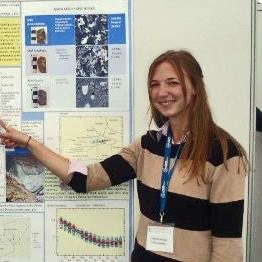Jessica Wilson

B.Sc. (Honours) Thesis
Geochemistry of Igneous Rocks Associated with the MMH Porphyry Copper Deposit, Chuquicamata District, Chile
(PDF - 33 Mb)
The MMH deposit is located 7 km to the south of the Chuquicamata mine within the Chuquicamata District in northern Chile, in the Domeyko Cordillera. The two deposits are located on opposite sides of the West Fault, a section of a regional (Domeyko) orogen-parallel fault system with ca. 35 km of strike-slip displacement. The MMH has a tabular shape, parallel to and adjoining the West Fault. MMH, held and operated by the state-owned company CODELCO, contains resources of more than one billion tonnes of copper ore, and is being prepared for open pit mining.
The focus of this thesis is the igneous geochemistry of the MMH deposit. The ore at MMH is hosted by the MM Granodiorite (Triassic; U-Pb in zircon 237-222 Ma), which is intruded by the MM Porphyry (Eocene; U-Pb in zircon 39 Ma) and the MM Quartz Porphyry (Eocene; U-Pb in zircon 36 Ma). The deposit contains Cu-(Mo) porphyry type mineralization (Re-Os in molybdenite < 37.3 Ma) and potassic alteration at depth, overprinted at higher levels by a younger (32-31 Ma), high sulphidation Cu-(Ag-As) ore characterized by high-grade hydrothermal breccia bodies. The genetic relationship between the Cu-(Mo) and Cu-(Ag-As) mineralization and Tertiary porphyries is still to be proven.
Trace elements geochemistry reveals that the Triassic MM Granodiorite and the Eocene MM Porphyry have nearly identical trace-element geochemical signatures. Both are the equivalent of volcanic or sub-volcanic andesite, whereas the Eocene MM Quartz Porphyry is closer to a rhyodcacite in composition. All have calc-alkaline - to some extent adakitic - characteristics. Electron microprobe analyses show that whereas the plagioclase in MM Granodiorite has been pervasively albitized, the plagioclase in MM Porphyry is oligoclase-andesine.
The surprising geochemical similarity between Triassic and Eocene host rocks suggests that tectonic conditions and magma generation in the Triassic was not very different to the Tertiary for this region of northern Chile. These results are in conflict with the commonly held thinking that the Triassic was a time of tectonic extension and relaxation. One implication is that the Triassic and Paleozoic basement in the Domeyko Cordillera may be more prospective for porphyry copper type deposits than previously thought. Another implication is that the composition of the mantle and lower crust in the Domeyko Cordillera may have more to do with the formation of giant porphyry type copper-molybdenum deposits than previously envisaged.
The MMH igneous host rocks have geochemical similarities with the Fortuna Igneous Complex, which is juxtaposed to the Chuquicamata deposit west of the West Fault, and with the El Abra Prophyry Complex, which is 35 km north, on the east side of the regional fault.
Keywords:
Pages: 213
Supervisor: Marcos Zentilli



